Massimo Caccia
Just-in-time Episodic Feedback Hinter: Leveraging Offline Knowledge to Improve LLM Agents Adaptation
Oct 05, 2025Abstract:Large language model (LLM) agents perform well in sequential decision-making tasks, but improving them on unfamiliar domains often requires costly online interactions or fine-tuning on large expert datasets. These strategies are impractical for closed-source models and expensive for open-source ones, with risks of catastrophic forgetting. Offline trajectories offer reusable knowledge, yet demonstration-based methods struggle because raw traces are long, noisy, and tied to specific tasks. We present Just-in-time Episodic Feedback Hinter (JEF Hinter), an agentic system that distills offline traces into compact, context-aware hints. A zooming mechanism highlights decisive steps in long trajectories, capturing both strategies and pitfalls. Unlike prior methods, JEF Hinter leverages both successful and failed trajectories, extracting guidance even when only failure data is available, while supporting parallelized hint generation and benchmark-independent prompting. At inference, a retriever selects relevant hints for the current state, providing targeted guidance with transparency and traceability. Experiments on MiniWoB++, WorkArena-L1, and WebArena-Lite show that JEF Hinter consistently outperforms strong baselines, including human- and document-based hints.
GitChameleon: Evaluating AI Code Generation Against Python Library Version Incompatibilities
Jul 16, 2025Abstract:The rapid evolution of software libraries poses a considerable hurdle for code generation, necessitating continuous adaptation to frequent version updates while preserving backward compatibility. While existing code evolution benchmarks provide valuable insights, they typically lack execution-based evaluation for generating code compliant with specific library versions. To address this, we introduce GitChameleon, a novel, meticulously curated dataset comprising 328 Python code completion problems, each conditioned on specific library versions and accompanied by executable unit tests. GitChameleon rigorously evaluates the capacity of contemporary large language models (LLMs), LLM-powered agents, code assistants, and RAG systems to perform version-conditioned code generation that demonstrates functional accuracy through execution. Our extensive evaluations indicate that state-of-the-art systems encounter significant challenges with this task; enterprise models achieving baseline success rates in the 48-51\% range, underscoring the intricacy of the problem. By offering an execution-based benchmark emphasizing the dynamic nature of code libraries, GitChameleon enables a clearer understanding of this challenge and helps guide the development of more adaptable and dependable AI code generation methods. We make the dataset and evaluation code publicly available at https://github.com/mrcabbage972/GitChameleonBenchmark.
The BrowserGym Ecosystem for Web Agent Research
Dec 10, 2024



Abstract:The BrowserGym ecosystem addresses the growing need for efficient evaluation and benchmarking of web agents, particularly those leveraging automation and Large Language Models (LLMs) for web interaction tasks. Many existing benchmarks suffer from fragmentation and inconsistent evaluation methodologies, making it challenging to achieve reliable comparisons and reproducible results. BrowserGym aims to solve this by providing a unified, gym-like environment with well-defined observation and action spaces, facilitating standardized evaluation across diverse benchmarks. Combined with AgentLab, a complementary framework that aids in agent creation, testing, and analysis, BrowserGym offers flexibility for integrating new benchmarks while ensuring consistent evaluation and comprehensive experiment management. This standardized approach seeks to reduce the time and complexity of developing web agents, supporting more reliable comparisons and facilitating in-depth analysis of agent behaviors, and could result in more adaptable, capable agents, ultimately accelerating innovation in LLM-driven automation. As a supporting evidence, we conduct the first large-scale, multi-benchmark web agent experiment and compare the performance of 6 state-of-the-art LLMs across all benchmarks currently available in BrowserGym. Among other findings, our results highlight a large discrepancy between OpenAI and Anthropic's latests models, with Claude-3.5-Sonnet leading the way on almost all benchmarks, except on vision-related tasks where GPT-4o is superior. Despite these advancements, our results emphasize that building robust and efficient web agents remains a significant challenge, due to the inherent complexity of real-world web environments and the limitations of current models.
WorkArena++: Towards Compositional Planning and Reasoning-based Common Knowledge Work Tasks
Jul 07, 2024



Abstract:The ability of large language models (LLMs) to mimic human-like intelligence has led to a surge in LLM-based autonomous agents. Though recent LLMs seem capable of planning and reasoning given user instructions, their effectiveness in applying these capabilities for autonomous task solving remains underexplored. This is especially true in enterprise settings, where automated agents hold the promise of a high impact. To fill this gap, we propose WorkArena++, a novel benchmark consisting of 682 tasks corresponding to realistic workflows routinely performed by knowledge workers. WorkArena++ is designed to evaluate the planning, problem-solving, logical/arithmetic reasoning, retrieval, and contextual understanding abilities of web agents. Our empirical studies across state-of-the-art LLMs and vision-language models (VLMs), as well as human workers, reveal several challenges for such models to serve as useful assistants in the workplace. In addition to the benchmark, we provide a mechanism to effortlessly generate thousands of ground-truth observation/action traces, which can be used for fine-tuning existing models. Overall, we expect this work to serve as a useful resource to help the community progress toward capable autonomous agents. The benchmark can be found at https://github.com/ServiceNow/WorkArena/tree/workarena-plus-plus.
WorkArena: How Capable Are Web Agents at Solving Common Knowledge Work Tasks?
Mar 12, 2024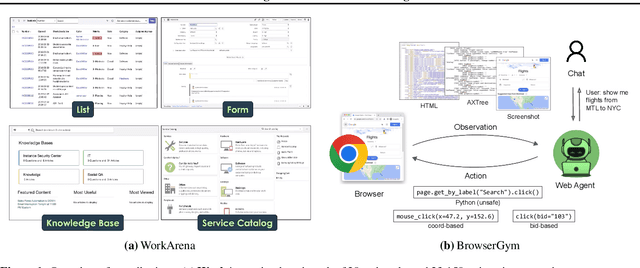
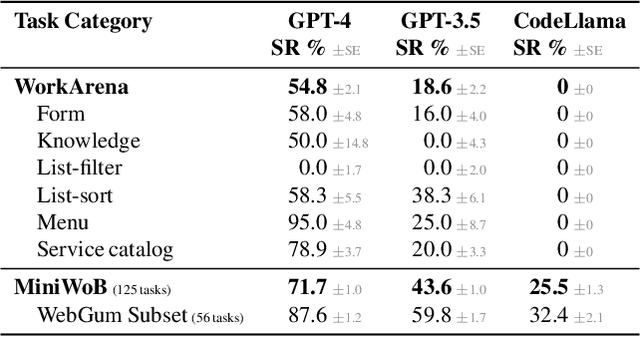
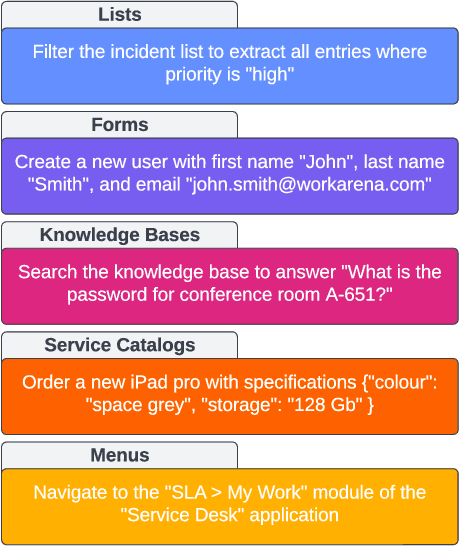
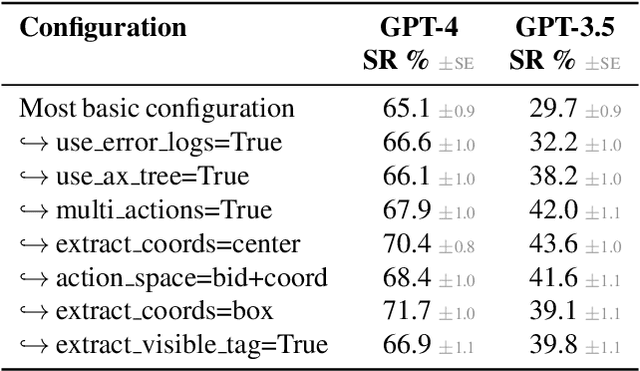
Abstract:We study the use of large language model-based agents for interacting with software via web browsers. Unlike prior work, we focus on measuring the agents' ability to perform tasks that span the typical daily work of knowledge workers utilizing enterprise software systems. To this end, we propose WorkArena, a remote-hosted benchmark of 29 tasks based on the widely-used ServiceNow platform. We also introduce BrowserGym, an environment for the design and evaluation of such agents, offering a rich set of actions as well as multimodal observations. Our empirical evaluation reveals that while current agents show promise on WorkArena, there remains a considerable gap towards achieving full task automation. Notably, our analysis uncovers a significant performance disparity between open and closed-source LLMs, highlighting a critical area for future exploration and development in the field.
Towards Compute-Optimal Transfer Learning
Apr 25, 2023



Abstract:The field of transfer learning is undergoing a significant shift with the introduction of large pretrained models which have demonstrated strong adaptability to a variety of downstream tasks. However, the high computational and memory requirements to finetune or use these models can be a hindrance to their widespread use. In this study, we present a solution to this issue by proposing a simple yet effective way to trade computational efficiency for asymptotic performance which we define as the performance a learning algorithm achieves as compute tends to infinity. Specifically, we argue that zero-shot structured pruning of pretrained models allows them to increase compute efficiency with minimal reduction in performance. We evaluate our method on the Nevis'22 continual learning benchmark that offers a diverse set of transfer scenarios. Our results show that pruning convolutional filters of pretrained models can lead to more than 20% performance improvement in low computational regimes.
NEVIS'22: A Stream of 100 Tasks Sampled from 30 Years of Computer Vision Research
Nov 15, 2022Abstract:We introduce the Never Ending VIsual-classification Stream (NEVIS'22), a benchmark consisting of a stream of over 100 visual classification tasks, sorted chronologically and extracted from papers sampled uniformly from computer vision proceedings spanning the last three decades. The resulting stream reflects what the research community thought was meaningful at any point in time. Despite being limited to classification, the resulting stream has a rich diversity of tasks from OCR, to texture analysis, crowd counting, scene recognition, and so forth. The diversity is also reflected in the wide range of dataset sizes, spanning over four orders of magnitude. Overall, NEVIS'22 poses an unprecedented challenge for current sequential learning approaches due to the scale and diversity of tasks, yet with a low entry barrier as it is limited to a single modality and each task is a classical supervised learning problem. Moreover, we provide a reference implementation including strong baselines and a simple evaluation protocol to compare methods in terms of their trade-off between accuracy and compute. We hope that NEVIS'22 can be useful to researchers working on continual learning, meta-learning, AutoML and more generally sequential learning, and help these communities join forces towards more robust and efficient models that efficiently adapt to a never ending stream of data. Implementations have been made available at https://github.com/deepmind/dm_nevis.
Task-Agnostic Continual Reinforcement Learning: In Praise of a Simple Baseline
May 28, 2022



Abstract:We study task-agnostic continual reinforcement learning (TACRL) in which standard RL challenges are compounded with partial observability stemming from task agnosticism, as well as additional difficulties of continual learning (CL), i.e., learning on a non-stationary sequence of tasks. Here we compare TACRL methods with their soft upper bounds prescribed by previous literature: multi-task learning (MTL) methods which do not have to deal with non-stationary data distributions, as well as task-aware methods, which are allowed to operate under full observability. We consider a previously unexplored and straightforward baseline for TACRL, replay-based recurrent RL (3RL), in which we augment an RL algorithm with recurrent mechanisms to address partial observability and experience replay mechanisms to address catastrophic forgetting in CL. Studying empirical performance in a sequence of RL tasks, we find surprising occurrences of 3RL matching and overcoming the MTL and task-aware soft upper bounds. We lay out hypotheses that could explain this inflection point of continual and task-agnostic learning research. Our hypotheses are empirically tested in continuous control tasks via a large-scale study of the popular multi-task and continual learning benchmark Meta-World. By analyzing different training statistics including gradient conflict, we find evidence that 3RL's outperformance stems from its ability to quickly infer how new tasks relate with the previous ones, enabling forward transfer.
Continual Learning via Local Module Composition
Nov 15, 2021



Abstract:Modularity is a compelling solution to continual learning (CL), the problem of modeling sequences of related tasks. Learning and then composing modules to solve different tasks provides an abstraction to address the principal challenges of CL including catastrophic forgetting, backward and forward transfer across tasks, and sub-linear model growth. We introduce local module composition (LMC), an approach to modular CL where each module is provided a local structural component that estimates a module's relevance to the input. Dynamic module composition is performed layer-wise based on local relevance scores. We demonstrate that agnosticity to task identities (IDs) arises from (local) structural learning that is module-specific as opposed to the task- and/or model-specific as in previous works, making LMC applicable to more CL settings compared to previous works. In addition, LMC also tracks statistics about the input distribution and adds new modules when outlier samples are detected. In the first set of experiments, LMC performs favorably compared to existing methods on the recent Continual Transfer-learning Benchmark without requiring task identities. In another study, we show that the locality of structural learning allows LMC to interpolate to related but unseen tasks (OOD), as well as to compose modular networks trained independently on different task sequences into a third modular network without any fine-tuning. Finally, in search for limitations of LMC we study it on more challenging sequences of 30 and 100 tasks, demonstrating that local module selection becomes much more challenging in presence of a large number of candidate modules. In this setting best performing LMC spawns much fewer modules compared to an oracle based baseline, however, it reaches a lower overall accuracy. The codebase is available under https://github.com/oleksost/LMC.
Learning where to learn: Gradient sparsity in meta and continual learning
Oct 27, 2021
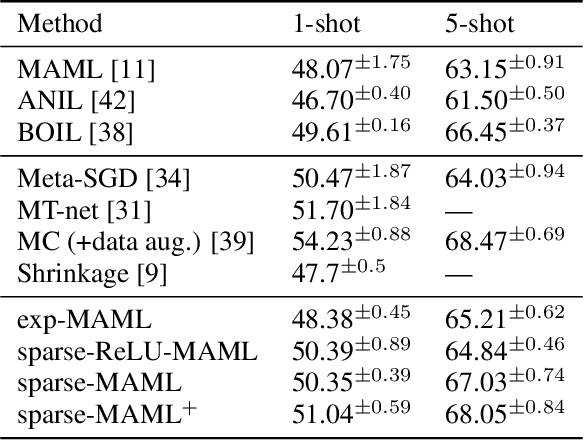

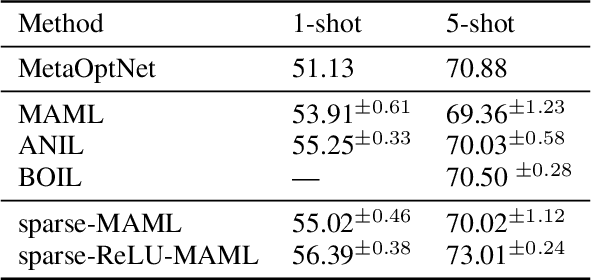
Abstract:Finding neural network weights that generalize well from small datasets is difficult. A promising approach is to learn a weight initialization such that a small number of weight changes results in low generalization error. We show that this form of meta-learning can be improved by letting the learning algorithm decide which weights to change, i.e., by learning where to learn. We find that patterned sparsity emerges from this process, with the pattern of sparsity varying on a problem-by-problem basis. This selective sparsity results in better generalization and less interference in a range of few-shot and continual learning problems. Moreover, we find that sparse learning also emerges in a more expressive model where learning rates are meta-learned. Our results shed light on an ongoing debate on whether meta-learning can discover adaptable features and suggest that learning by sparse gradient descent is a powerful inductive bias for meta-learning systems.
 Add to Chrome
Add to Chrome Add to Firefox
Add to Firefox Add to Edge
Add to Edge